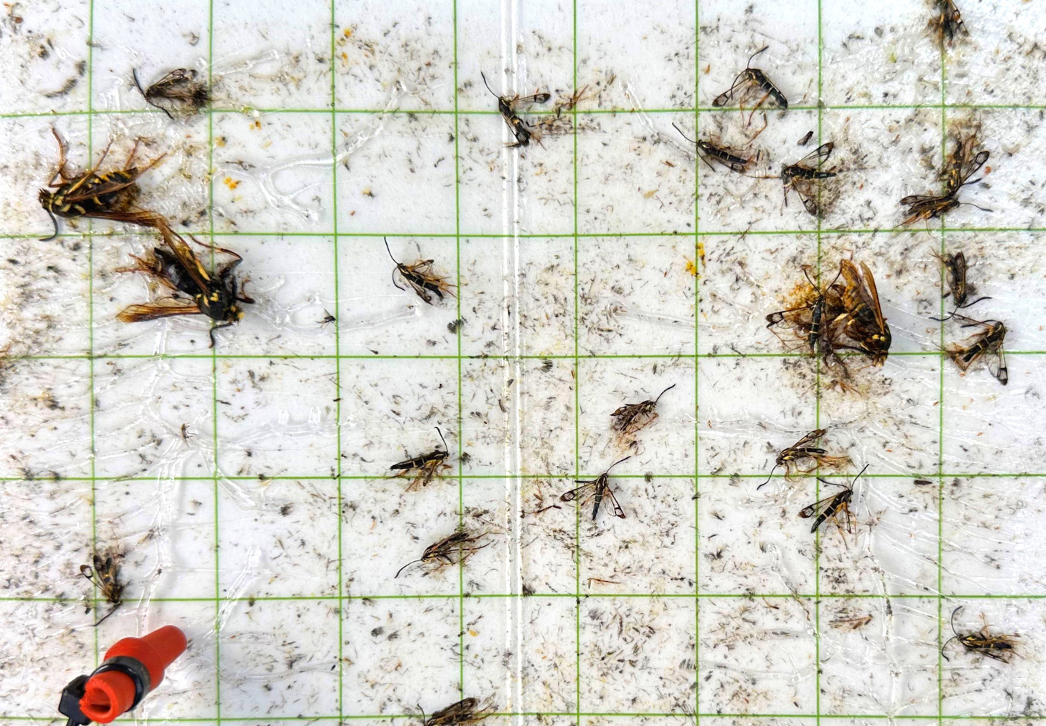|
|
Scattered showers and storms covered most of the state this week and were particularly heavy (over 2 inches) in parts of the west-central and northwest regions. The Village of Roberts in St. Croix County recorded a two-day total of 3.2 inches July 3-4, while nearby Baldwin received 2.4 inches. Despite the encouraging rainfall, many locations continue to experience seasonal moisture deficits since June 1, specifically in the southern areas.
Survey activities for the week ending July 6 included scouting for soybean pests, monitoring pheromone traps for western bean cutworm and true armyworm, and setting traps for forest pests such as spongy moth and velvet longhorned beetle. Spongy moth mating disruption treatments, which have been hampered this season due to reduced visibility from wildfire smoke, are scheduled to resume next week in northwestern Wisconsin.
__________________________________
|
|
|
The annual western bean cutworm moth flight continued for the third week. Counts have been very low as of July 6, with only nine of DATCP’s 41 monitoring sites reporting 1-4 moths per trap. Scouting corn plants should begin as fields enter the late-whorl and pre-tassel stages. If egg masses and small larvae are found on 5% or more of the plants and control is warranted, the optimal timing for insecticide treatment is at 90-95% tassel emergence. This application timing increases the chance that the caterpillars will be exposed to the insecticide.
Moth counts will be available for the next six weeks on the DATCP Western Bean Cutworm monitoring network page. In addition, WBCW degree day accumulations are provided in the modified base 38°F column in our degree day table. The lower threshold for WBCW is 38°F while the upper threshold is 75°F. Once 2,577 degree-days are reached, 25% of the WBCW flight has occurred and scouting should begin. Emergence of 25% of this year’s moth population is expected July 12-25 across the southern half of Wisconsin.
In addition to the western bean cutworm flight, corn rootworm beetle emergence is also beginning. Beetles of the northern species were observed on July 5 in Rock County. These insects will become increasingly common this month, with peak emergence anticipated by mid-August. According to DATCP’s 2022 corn rootworm survey results, beetle counts were high across much of the southern half of Wisconsin for the second year in a row and susceptible continuous corn fields in this region are at heightened risk of damaging larval infestations this summer. The 2022 state average count of 0.9 beetle per plant was an increase from 0.8 beetle per plant in 2021 and the highest average in more than a decade (since 2008). Areas most at risk of experiencing larval rootworm damage this season are the southwest, south-central, and east-central crop districts.
     
|
|
 __________________________________
|
|
|
Reports from DATCP’s apple orchard pest monitoring network indicate the first apple maggot flies of the season are emerging. Apple growers concerned about this pest can set a minimum of three red sphere traps per 10 acres in early-ripening cultivars, and one trap every 200-300 feet in perimeter trees adjacent to wild hosts. The traps should be placed at eye-level and be clearly visible on the outside edge of the canopy. Home gardeners may also use the visual traps to monitor apple maggot. The economic threshold for control is one fly per unbaited trap per week or five flies per baited trap per week.
Japanese beetle pressure is likewise increasing in Wisconsin apple orchards and vineyards. Damage to fruit trees, ornamentals and field crops will intensify this month and management may be warranted. If scouting indicates the need for control, targeted spot treatment of individual trees or problem areas is usually an effective alternative to broadcast applications, which harm non-target and beneficial insects. Most chemical treatments are only effective against Japanese beetle when populations are low and the beetles are first migrating into orchards, vineyards, or other crops.
Dogwood borer moths have been appearing in orchard pheromone traps since early June. The traps do not indicate the need for control, but instead signal when to start scouting for evidence of larval feeding, such as frass around the graft union of trees. DATCP cooperators should be aware that the commercially available dogwood borer pheromone lure attracts several native clearwing moth species, therefore accurate identification is important. The correct height for traps is 3-4 feet above the ground. Scouting for this pest is most critical for orchards with new trees planted in the last five years.
In the photos below, the smaller specimens are male dogwood borers while the larger insects are non-targets. Male dogwood borers can be identified by the two yellow bands on the abdomen (see enlarged second photo).
  Dogwood borer males (smaller), Non-target (larger)
Laura Tisch Munchkey Apples
 Male dogwood borers have two bands on abdomen
Laura Tisch Munchkey Apples
|
|
 __________________________________
|
|
|
|